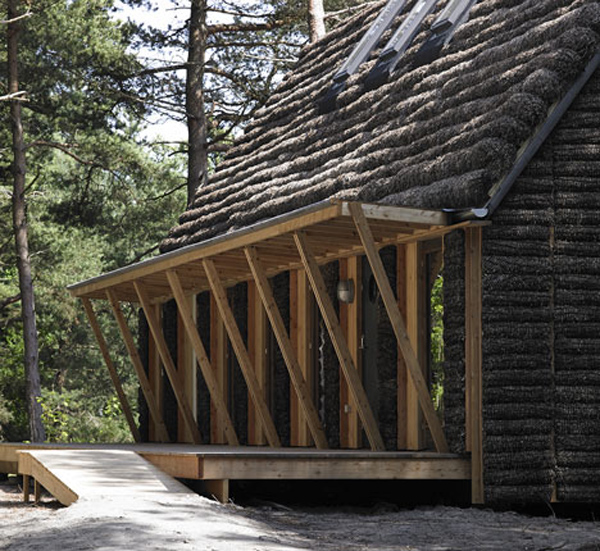
“Seaweed pillows [knit mesh tubes filled with dried seaweed] were used as cladding for this holiday house on the Danish island of Læsø by architecture studio Vandkunsten and non-profit organisation Realdania Byg.
The Modern Seaweed House revisits the traditional construction method in Læsø, where for many centuries trees were scarce but seaweed has always been abundant on the beaches. At one stage there were hundreds of seaweed-clad houses (‘Zostera marina’ seaweed) on the island but now only around 20 remain, which prompted Realdania Byg to initiate a preservation project.
The team enlisted Vandkunsten to design a new house that combines the traditional material with twenty-first century construction techniques.
“Seaweed is at the same time very old and very ‘just-in-time’, because it is in many ways the ultimate sustainable material,” Realdania Byg’s Jørgen Søndermark told Dezeen.
“It reproduces itself every year in the sea, it comes ashore without any effort from humans, and it is dried on nearby fields by sun and wind,” he continued. “It insulates just as well as mineral insulation, it is non-toxic and fireproof, and it has an expected life of more than 150 years!”
Read more at the source: Dezeen Magazine
Related: Turning seaweed into construction insulation
“Although the natural material of the Neptune grass is regarded as waste, this readily abundant material has a variety of characteristics that make it useful in construction. Neptune grass seaweed is virtually non-flammable, resistant to mold, and it can be used as insulating material without the need for chemical additives. It can be used as insulation between the rafters of pitched roofs, to insulate interior walls, or to reduce the amount of heat lost through building envelopes. And with a salt content of just 0.5 to 2 percent, Neptune grass can be used to produce insulation material that will not rot away. seaweed is 100 percent organic and entirely free of toxic matter, making it also particularly suitable for allergy sufferers.”
Thanks to Patti for sending this tip.

Why bother processing it into boards for an earthbag house? Why not just put it into the same kind of small tubes used for a thin wall and wrap it around you’re structure, or used the divided bags/tubes. If you’re trying to green an otherwise conventional construction I can see it, but if you’re building with any of the alternative methods recommended on this site, you might as well go whole hog.
Thanks Owen for the blog and YES this seems to be a far better alternative to foam board. I wonder how this could be used in the earthbag building process? Any idea?
Like I’ve said before on the blog, many modern adobe houses have a layer of foam board on the exterior and plaster. The same option exists for earthbag houses. Seaweed board would make the process greener.
This is interesting. I wonder what other countries might be using this? I do question about it not burning when it’s dry but, honestly I have never tried to but, have complained about it on the beaches. Maybe not so much now.
The 2nd article says Mediterranean countries are harvesting the seaweed and sending it to a factory in Germany who then process it into finished insulation. They’re planning to also make rigid panels such as cellulose board to increase sales. Things are always slow at first, but if this works than it will catch on and spread elsewhere. So I consider this very good news for the natural building movement. I’ve always hated using foam board insulation. Soon we’ll be able to buy seaweed board with 150 year life expectancy unless a competing technology comes to market sooner.